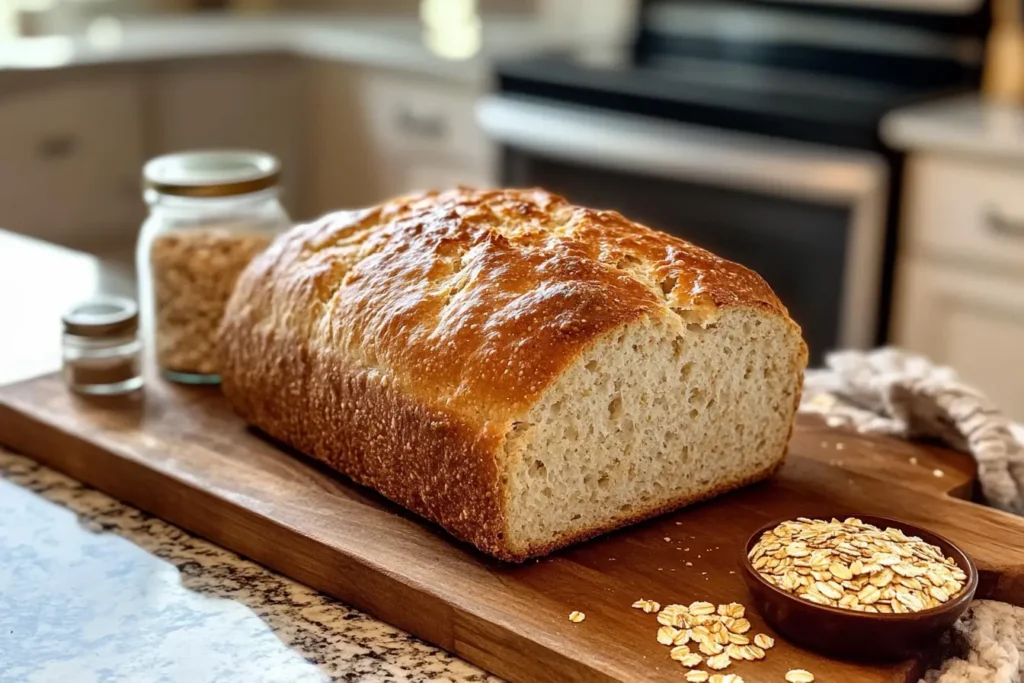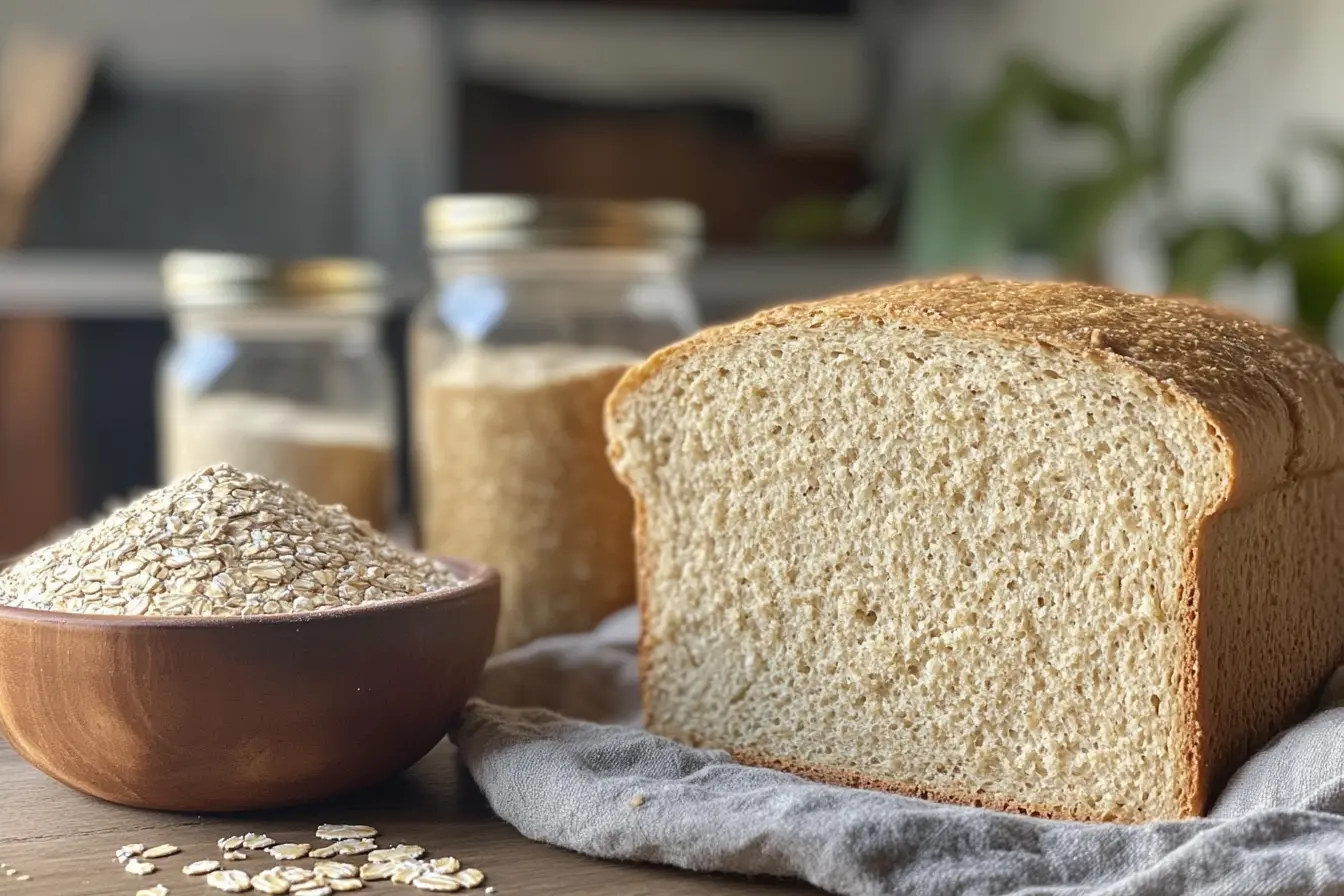Introduction
Oat flour is a versatile and nutritious ingredient that has become a favorite for health-conscious bakers. But one question often arises: does oat flour rise with yeast? This article explores the science behind oat flour’s interaction with yeast, the challenges it presents, and practical tips for creating fluffy, yeast-leavened oat bread. By understanding the role of gluten, binding agents, and various techniques, you’ll be equipped to bake with confidence. Let’s dive into the details!
Understanding Oat Flour and Its Unique Properties
What is Oat Flour?
Oat flour is made by finely grinding whole oats into a soft, powdery consistency. Unlike all-purpose or wheat flour, it lacks gluten, the protein responsible for elasticity and structure in traditional bread dough. This fundamental difference plays a crucial role in how it behaves with yeast and other leavening agents.
Nutritional Profile of Oat Flour
Rich in dietary fiber, particularly beta-glucans, oat flour supports heart health and digestion. It’s also packed with essential nutrients like manganese, magnesium, and iron. These properties make it a nutritious alternative to refined flours.
- Calories: ~120 per 1/4 cup
- Protein: 4g
- Carbs: 21g
- Fiber: 3g
- Fat: 2g
How Oat Flour Differs from Wheat Flour
The absence of gluten in oat flour is its defining characteristic. Gluten provides the elasticity that allows bread dough to stretch and trap gases during fermentation. Without it, oat flour dough struggles to hold its shape and volume, often resulting in a denser texture.
Why Use Oat Flour in Baking?
Despite these challenges, bakers use oat flour for its health benefits, subtle nutty flavor, and natural sweetness. Additionally, it’s a fantastic option for those seeking gluten-free alternatives.
In the subsequent chapter, we’ll explore the fascinating role yeast plays in baking and why gluten is so important for successful leavening.
The Role of Yeast and a Recipe for Oat Flour Bread
How Yeast Works in Baking
Yeast, a living organism, plays a pivotal role in baking by fermenting sugars in the dough. This process produces carbon dioxide, which gets trapped in the gluten network, causing the dough to rise and develop a light, airy texture. However, in oat flour, the absence of gluten complicates this process.
Without gluten, the gases released by yeast can escape, resulting in a dense and compact bread. To overcome this, bakers rely on techniques like using binding agents, blending flours, or adding leavening enhancers.
A Simple Oat Flour Bread Recipe with Yeast
Here’s a straightforward recipe for baking oat flour bread that rises beautifully with yeast.

Ingredients:
- 2 ½ cups oat flour (gluten-free certified if needed)
- 1 cup warm water (110°F or 45°C)
- 2 ¼ teaspoons active dry yeast (1 packet)
- 1 tablespoon honey or maple syrup (for yeast activation)
- 1 teaspoon salt
- 2 tablespoons olive oil
- 1 tablespoon psyllium husk or xanthan gum (binding agent)
- Optional: Herbs or seeds for flavor
Instructions:
- Activate the Yeast:
In a small bowl, dissolve honey or maple syrup in warm water. Sprinkle the yeast on top and let it sit for 5-10 minutes until frothy. This indicates that the yeast is active. - Mix the Dry Ingredients:
In a large mixing bowl, combine oat flour, salt, and psyllium husk or xanthan gum. Stir well to ensure even distribution. - Incorporate Wet Ingredients:
Add the yeast mixture and olive oil to the dry ingredients. Stir until a dough forms. It will be sticky and slightly wet, which is normal for oat flour dough. - Knead the Dough:
Transfer the dough onto a lightly floured surface (use oat flour). Knead gently for about 5 minutes. If the dough feels too sticky, sprinkle a little more oat flour. - Proof the Dough:
Shape the dough into a ball and place it in a greased bowl. Cover with a damp cloth and let it rise in a warm place for 1-2 hours or until it doubles in size. - Shape and Second Rise:
Punch down the dough to release air. Shape it into a loaf and place it in a greased loaf pan. Let it rise again for 30-45 minutes. - Bake the Bread:
Preheat your oven to 375°F (190°C). Bake the loaf for 30-35 minutes, or until the top is golden brown and a toothpick inserted in the center comes out clean. - Cool and Serve:
Allow the bread to cool in the pan for 10 minutes before transferring it to a wire rack. Slice and enjoy!
Nutritional Content (Per 100g)
| Nutrient | Amount |
|---|---|
| Calories | 210 kcal |
| Carbohydrates | 38 g |
| Fiber | 5 g |
| Protein | 6 g |
| Fat | 4 g |
| Iron | 1.8 mg |
| Potassium | 150 mg |
Moving forward to the next topic, we’ll address the challenges of using oat flour with yeast and how to overcome them for better baking results.
Overcoming Challenges When Using Oat Flour with Yeast
Challenges of Using Oat Flour with Yeast
When baking with oat flour, one of the biggest hurdles is its lack of gluten. Gluten acts as a stretchy net that traps gases produced by yeast during fermentation, giving bread its rise and airy texture. Without this elasticity, oat flour dough tends to produce dense and crumbly bread.
Another issue is the absorbent nature of oat flour, which leads to a wetter dough that can be challenging to work with. Additionally, achieving a good rise often requires strategic modifications, as oat flour alone doesn’t offer the structural support that yeast-leavened bread needs.
Techniques to Improve Rise in Oat Flour Dough
1. Blend with Gluten-Containing Flours
If your diet allows, mixing oat flour with a gluten-containing flour like whole wheat or bread flour can significantly improve rise and texture. A common ratio is 50% oat flour to 50% wheat flour, striking a balance between structure and nutrition.
2. Use Binding Agents
Adding psyllium husk, xanthan gum, or flaxseed meal creates a gel-like consistency that mimics gluten’s elasticity. These agents help trap gases and hold the dough together. For instance:
- Add 1 tablespoon of psyllium husk or xanthan gum per cup of oat flour.
- For flaxseed meal, mix 1 tablespoon with 3 tablespoons of water and let it thicken before adding to the dough.
3. Incorporate Vital Wheat Gluten
For those who are not gluten-free but still want the benefits of oat flour, vital wheat gluten can be a game-changer. Adding 1 tablespoon of vital wheat gluten per cup of oat flour strengthens the dough, improving its ability to rise and maintain shape.
4. Add More Liquid
Oat flour’s absorbency often calls for more liquid in recipes. Ensure the dough is adequately hydrated to help with fermentation and rise. A soft, sticky dough is ideal for yeast-leavened oat bread.
5. Adjust Proofing Time
Give your dough extra time to rise, as oat flour-based dough ferments more slowly than wheat-based dough. Keep the dough in a warm, draft-free environment to maximize yeast activity.
Alternative Leavening Techniques
If yeast alone doesn’t deliver the desired results, consider supplementing it with other leavening agents like baking powder or baking soda. These agents work alongside yeast to provide additional lift and volume to oat flour bread.
Advancing to the next topic, we’ll explore how additives like xanthan gum and psyllium husk can be used to further enhance the quality of oat flour bread.
Enhancing Oat Flour Bread with Additives
The Role of Additives in Oat Flour Baking
Additives like xanthan gum, psyllium husk, and flaxseed meal are essential when baking with oat flour, as they compensate for the lack of gluten. These ingredients improve dough elasticity, texture, and the ability to trap gases from yeast fermentation, resulting in a loaf that rises better and holds its shape.
Using Vital Wheat Gluten
Vital wheat gluten is a concentrated form of gluten protein that enhances the structure of oat flour bread. Adding just a small amount can:
- Improve dough elasticity.
- Strengthen the crumb structure.
- Boost the bread’s ability to rise.
How to Use:
- Mix 1 tablespoon of vital wheat gluten per cup of oat flour.
- Combine thoroughly with dry ingredients before adding liquids to ensure even distribution.
Incorporating Xanthan Gum or Psyllium Husk
Xanthan Gum:
A popular choice for gluten-free baking, xanthan gum acts as a stabilizer and thickener. It helps bind ingredients and trap air bubbles, making the bread lighter and less crumbly.
How to Use:
- Add 1 teaspoon of xanthan gum per cup of oat flour.
- Stir it into the dry ingredients before combining with wet ones.
Psyllium Husk:
Psyllium husk, a natural fiber, works wonders in gluten-free dough by forming a gel-like consistency when mixed with water. This property helps oat flour dough retain moisture and rise effectively.
How to Use:
- Add 1 tablespoon of psyllium husk per cup of oat flour.
- Mix it with water (3 tablespoons of water per tablespoon of psyllium husk) and let it sit for 5 minutes before adding to the dough.

Flaxseed Meal as a Natural Binder
Flaxseed meal is another excellent option for improving the rise and texture of oat flour bread. When combined with water, it forms a thick gel that acts like gluten, providing structure to the dough.
How to Use:
- Mix 1 tablespoon of flaxseed meal with 3 tablespoons of water.
- Allow it to rest for 5 minutes until it thickens. Add it to the dough along with the wet ingredients.
Blending Oat Flour with Other Flours
To achieve the best results, consider blending oat flour with complementary gluten-free flours like almond flour, tapioca starch, or sorghum flour. This creates a more balanced dough that rises well without becoming overly dense.
Transitioning into the following chapter, we’ll delve into oat flour’s health benefits and its suitability for various dietary needs, including gluten-free and heart-healthy diets.
Health Benefits of Oat Flour Bread
Nutritional Advantages of Oat Flour Bread
Oat flour bread is a powerhouse of nutrients, offering benefits that extend beyond just being a tasty gluten-free alternative. Let’s explore its key nutritional perks:
- High in Fiber: Oat flour is rich in beta-glucans, a type of soluble fiber that helps lower cholesterol levels and supports heart health. This makes oat flour bread an excellent choice for those aiming to improve cardiovascular well-being.
- Rich in Protein: Oat flour contains more protein than many other gluten-free flours, aiding muscle repair and keeping you feeling fuller for longer.
- Loaded with Micronutrients: Essential minerals like magnesium, manganese, and phosphorus contribute to energy production, bone health, and overall cellular function.
- Low Glycemic Index: Oat flour bread releases energy slowly, making it ideal for stabilizing blood sugar levels and preventing energy crashes.
Suitability for Gluten-Free Diets
For individuals with gluten intolerance or celiac disease, oat flour bread can be a game-changer. However, it’s vital to ensure the oat flour used is certified gluten-free, as cross-contamination during processing can pose a risk.
Who Can Benefit from Oat Flour Bread?
- Diabetics: Its low glycemic impact helps manage blood sugar levels effectively.
- Heart Health Enthusiasts: The cholesterol-lowering properties of beta-glucans make it a heart-smart choice.
- Weight Watchers: Its high fiber content promotes satiety, curbing overeating.
- Athletes: The combination of protein and complex carbs provides sustained energy for active lifestyles.
Additional Dietary Considerations
Oat flour bread is not only gluten-free but also adaptable to various diets:
- Vegetarian-Friendly: Its natural ingredients align well with plant-based eating.
- Low-FODMAP Option: Oats are considered safe for many individuals managing digestive issues.
- Allergy-Friendly: Free from common allergens like dairy and soy when prepared with simple ingredients.
Frequently Asked Questions
Is lentil bread high in carbs?
Lentil bread contains carbohydrates, but it is generally lower in net carbs compared to traditional bread due to its high fiber content. A typical slice has around 15-20 grams of total carbs, with 5-7 grams of fiber, leaving a net carb content of approximately 8-13 grams. This makes lentil bread a suitable option for those watching their carb intake, especially when paired with low-carb or nutrient-dense foods.
What is the best way to cook diced chicken?
The best way to cook diced chicken depends on your preferences and recipe. Here are some methods:
- Stir-Frying: Cook diced chicken in a skillet with a little oil over medium-high heat. Add spices, herbs, and vegetables for a quick, flavorful meal.
- Grilling: Marinate chicken pieces, skewer them, and grill until cooked through for a smoky, charred flavor.
- Baking: Season diced chicken and bake in the oven at 375°F (190°C) for 20-25 minutes, turning once, for a juicy and tender texture.
- Boiling: Cook chicken in simmering broth or water for use in soups or salads. This method keeps the chicken moist and mild in flavor.
Is diced chicken healthy?
Yes, diced chicken is an excellent source of lean protein, low in fat, and packed with essential nutrients like vitamin B6, niacin, and selenium. It is versatile and can be paired with vegetables, grains, or legumes to create balanced meals. Diced chicken supports muscle growth, boosts metabolism, and helps maintain a healthy immune system. Opt for skinless chicken to reduce fat and cholesterol content.
Conclusion
Baking with oat flour opens up a world of nutritious and flavorful possibilities, but it also comes with unique challenges. While oat flour lacks gluten, which is essential for yeast-leavened bread to rise, creative techniques and the use of additives like psyllium husk, xanthan gum, or vital wheat gluten can help you achieve satisfying results. These methods enhance the dough’s structure and elasticity, allowing you to enjoy a softer, more evenly risen loaf.
The benefits of oat flour bread go beyond its versatility in baking. Its high fiber content supports heart health and digestion, while its low glycemic index helps stabilize blood sugar levels, making it ideal for a variety of dietary needs. Whether you’re managing diabetes, looking for gluten-free options, or simply aiming to eat more healthfully, oat flour bread offers a wholesome, nutrient-dense alternative to traditional bread.
Through the detailed recipe provided, you can confidently bake oat flour bread that combines the goodness of oats with the leavening power of yeast. With a little practice and experimentation, the possibilities are endless—so why not give it a try? Baking with oat flour not only transforms your meals but also promotes better health, one slice at a time.
As you continue your culinary journey, remember that success often lies in adaptation and creativity. Happy baking!

